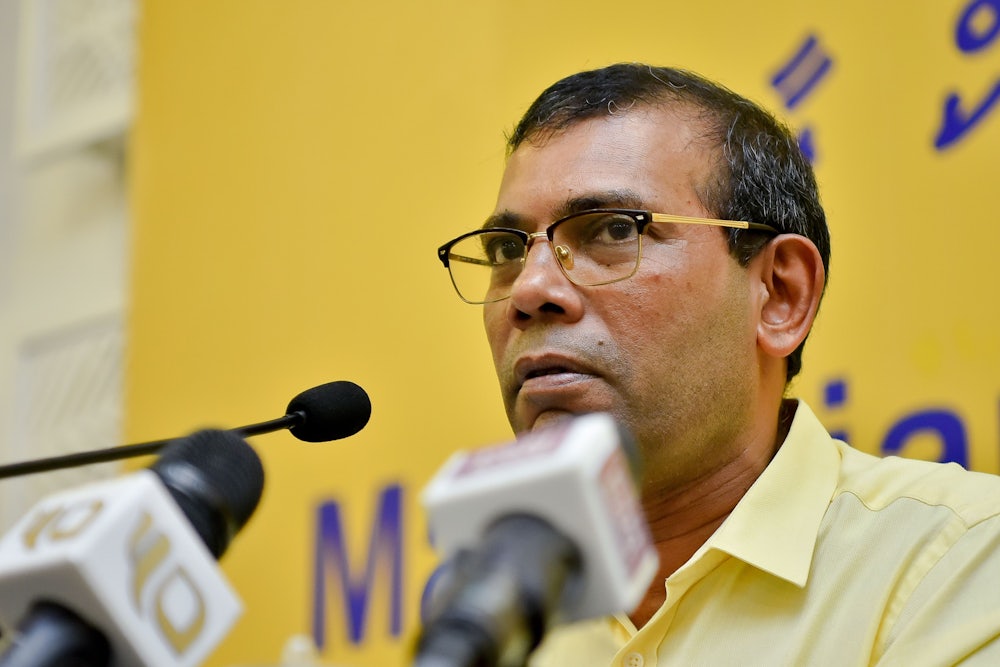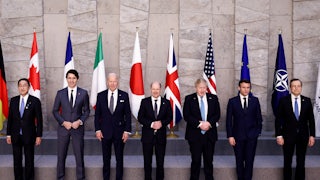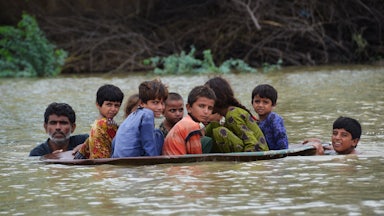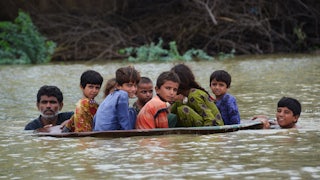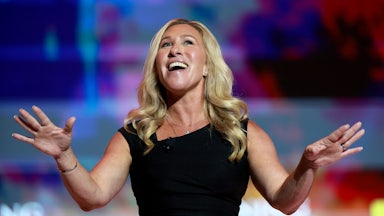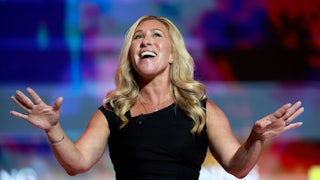As the United States and the world lurch toward a recession, the poorest and most vulnerable countries face a seemingly impossible set of circumstances. The group of 58 climate-vulnerable countries known as the V20 have lost 20 percent of their combined gross domestic product this century due to climate damages, according to a recent report. Meanwhile, these poorer countries also face rising food and commodity costs, the devastating effects of Covid-19, and ongoing vaccine apartheid. As the Federal Reserve moves to raise interest rates in the name of combating inflation, V20 nations appear to be reaching a breaking point. “The climate crisis is the debt crisis,” said Sara Jane Ahmed, finance advisor to the V20.
Ahead of a meeting of V20 finance ministers that began this week in Geneva—scheduled to occur on the heels of International Monetary Fund and World Bank meetings in Washington—former Maldives President Mohamad Nasheed suggested countries in the bloc might stop making payments on the $686.3 billion they owe, accounting for nearly 30 percent of those countries’ combined GDP. It’s an indicator of just how dire circumstances have become. And it ought to be a wake-up call for rich countries to put serious debt relief back on the table.
The numbers are stark: Fifty-five V20 countries are due to pay back $435.8 billion over the next six years, researchers at Boston University’s Global Development Policy Center have found. The IMF has warned that 60 percent of low-income countries overall are now either in or at high risk of debt distress. Troublingly, the institution also recently predicted that “the worst is yet to come” for the global economy. A separate IMF working paper found that just seven of 29 low-income countries in need of additional financing for climate adaptation have the necessary fiscal space to make those investments.
Climate-vulnerable countries are demanding that the international financial system represented by the World Bank and the IMF “become fit for climate and for our development ambitions,” V20 chair and Ghanian Finance Minister Ken Ofori-Atta said in his keynote address. Specifically, the bloc is calling for an overall reduction of debt levels across creditor classes, more flexibility from creditors, and ramped-up commitments from international institutions, including multilateral development banks, to finance climate adaptation. Along the lines of a proposal from Barbados’s Prime Minister Mia Mottley, they’ve also called on the IMF to issue additional special drawing rights, a basket reserve currency, and for wealthy countries to deliver on their still unmet $100 billion-per-year climate financing pledge, with funds balanced between mitigation and adaptation.
Nonpayment would be a dramatic, painful, and desperate measure. V20 countries—representing 1.4 billion people—command just 5.3 percent of votes at the IMF, “which makes it easy to be ignored,” says Kevin Gallagher, director of the Global Development Policy Center. As world leaders head to the U.N. climate conference colloquially known as COP27 early next month, climate finance is likely to be a major issue. But the U.N. is just one venue where a mounting climate finance challenge will need to be tackled. “This is hurricane season for the global economy,” Gallagher adds, referring to the compounding crises facing middle- and low-income countries that “have really blasted their fiscal space in trying to cope with it.”
Overlapping climate and debt crises create a vicious cycle, which a global recession will only exacerbate. “In the absence of other tools, when a road or house or electricity wires get swept away, there’s no risk financing or prearranged funds to resource that. Countries typically borrow just to replace the asset,” Ahmed told me.
While climate finance and debt relief tend to be framed as either moral obligations or acts of charity from wealthy countries to poorer ones, there are self-interested reasons for the U.S. and other wealthy governments to back calls for climate-conscious debt restructuring. Countries in “perpetual crisis,” Gallagher said, can’t export, import, or grow. “Those are lost export opportunities for countries around the world,” he added. “Financial instability anywhere can lead to financial instability everywhere.”
More than 35 percent of V20 sovereign debt is owed to private creditors, including asset managers PIMCO, Blackrock, and Vanguard. Twenty-eight percent is held by the World Bank and multilateral development banks; the U.S. is a major shareholder in nearly every one. China is the fifth-largest creditor to V20 countries, accounting for 7 percent of total debt load and 10 percent of the payments they need to make it through 2028.
Private creditors have come to play a more important role over the last decade. Amid soaring debt burdens in the mid-’90s, the IMF and World Bank embarked on an initiative to relieve debt for heavily indebted poor countries, or HIPCs. “Unfortunately when their slate got cleaned,” Gallagher explains, investors “saw developing countries as a new asset class. They could carry a lot more debt.” That dovetailed with quantitative easing after the financial crisis and the ballooning of major asset managers offering affordable passive investment products that promised steady yields. Developing countries found it easier to borrow, in dollars in particular. That also makes another HIPC Initiative–like round of structured debt relief more difficult, since bondholders are more diffuse and less accountable.
Overlapping crises and a strong dollar have made it impossible for some countries to service debt denominated in foreign currencies, dollars especially. And as lenders begin to factor climate risk into their rates, the cost of capital for indebted countries could rise even further. For oil-importing countries, that burden is even worse. Only a small minority of V20 countries collect sizable oil revenues. “They’re all concerned about being the next Pakistan,” Gallagher said, referring to the deadly floods in Pakistan that have piled at least $30 billion worth of damages onto an already crushing $100 billion external debt burden. Pakistan’s foreign exchange reserves stand at just $8.3 billion.
Gallagher and Ahmed were both pleased to see recent initiatives from international institutions to address climate concerns, including the Resilience and Sustainability Trust launched last spring, meant to redistribute IMF-issued special drawing rights, and Global Shield Against Climate Risk, a scheme to provide fast-acting insurance coverage to climate-vulnerable countries. But much more action is needed, they say.
After World Bank Secretary David Malpass drew fire last month for seeming to reject the scientific consensus on climate change, U.S. Treasury Secretary Janet Yellen urged the World Bank to develop a clear, holistic climate plan by the end of the year. “There are instruments out there. It’s just a matter of deploying them at speed, scale and ensuring that the quality of finance delivers resilience,” Ahmed said. “One thing we learned from the pandemic and climate-fueled risk is that the system and infrastructure we have isn’t quite resilient.”
